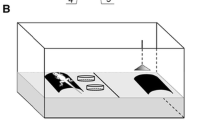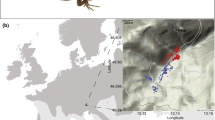Abstract
Viviparity in squamate reptiles is presumed to evolve in cold climates by selection for increasingly longer periods of egg retention. Longer periods of egg retention may require modifications to other reproductive features associated with the evolution of viviparity, including a reduction in eggshell thickness and clutch size. Field studies on the thermal and reproductive biology of high (HE) and low (LE) elevation populations of the oviparous lizard, Sceloporus scalaris, support these expectations. Both day and night-time temperatures at the HE site were considerably cooler than at the LE site, and the activity period was 2 h shorter at the HE than at the LE site. The median body temperature of active HE females was 2°C lower than that of LE females. HE females initiated reproduction earlier in the spring than LE females, apparently in order to compensate for relatively low temperatures during gestation. HE females retained eggs for about 20 days longer than LE females, which was reflected by differences in the degree of embryonic development at the time of oviposition (stages 35.5–37.0 versus stages 31.0–33.5, respectively). These results support the hypotheses that evolution of viviparity is a gradual process, and is favored in cold climates. Females in the HE population exhibited other traits consistent with presumed intermediate stages in the evolution of viviparity; mean eggshell thickness of HE eggs (19.3 μm) was significantly thinner than that of LE eggs (26.6 μm) and the size-adjusted clutch sizes of HE females (9.4) were smaller than those of LE females (11.2).
Similar content being viewed by others
References
Adolph SC, Porter WP (1993) Temperature, activity, and lizard life histories. Amer Nat 142:273–295
Andrews RM, Rose BR (1994) Evolution of viviparity: constraints on egg retention. Physiol Zool 67:1006–1024
Ballinger R (1983) Life history variations. In: Huey RB, Pianka ER, Schoener TW (eds) Lizard ecology: studies of a model organism. Harvard University Press, Cambridge, Mass, pp 241–260
Ballinger RE, Congdon JD (1981) Population ecology and life history strategy of a montane lizard (Sceloporus scalaris) in Southeastern Arizona. J Nat Hist 15:213–222
Beuchat CA (1988) Temperature effects during gestation in a viviparous lizard. J Therm Biol 13:135–142
Bock CE, Smith HM, Bock JH (1990) The effect of livestock grazing upon abundance of the lizard, Sceloporus scalaris, in Southeastern Arizona. J Herpetol 24:445–446
Braña F (1986) Ciclo reproductor y oviparismo de Lacerta vivipara en la Cordillera Cantábrica. Rev Esp Herpetol 1:273–291
Braña F, Bea A, Arrayago M (1991) Egg retention in lacertid lizards: relationships with reproductive ecology and the evolution of viviparity. Herpetology 47:218–226
Christian KA, Tracy CR, Porter WP (1986) The effect of cold exposure during incubation of Sceloporus undulatus eggs. Copeia 1986:1012–1014
Cowles RB, Bogert CM, (1944) A preliminary study of the thermal requirements of desert reptiles. Bull Am Mus Nat Hist 83:261–296
DeMarco V (1992) Embryonic development times and egg retention in four species of sceloporine lizards. Funct Ecol 6:436–444
DeMarco V, (1993) Estimating egg retention times in sceloporine lizards. J Herpetol 27:453–458
Dixon JR, Medica PA (1965) Noteworthy records of reptiles from New Mexico. Herpetology 21:72–75
Dufaure JP, Hubert J (1961) Table de développement du lézard vivipare: Lacerta (Zootoca) vivipara Jacquin. Arch Anat Microsc Morphol 50:309–328
Goldberg SR (1971) Reproductive cycle of the ovoviviparous iguanid lizard Sceloporus jarrovi Cope. Herpetology 27:123–131
Greer AE (1989) The biology and evolution of Australian lizards. Beatty, Chipping Norton, New South Wales, Australia
Guillette LJ Jr (1982) The evolution of viviparity and placentation in the high elevation, Mexican lizard Sceloporus aeneus. Herpetology 38:94–103
Guillette LJ Jr (1992) Morphology of the reproductive tract in a lizard exhibiting incipient viviparity (Spenomorphus fragilis) and its implications for the evolution of the reptilian placenta. J Morphol 212:1–11
Guillette LJ Jr (1993) The evolution of viviparity in lizards. Bioscience 43:742–751
Guillette LJ Jr, Jones RE, Fitzgerald KT, Smith HM (1980) Evolution of viviparity in the lizard genus Sceloporus. Herpetology 36:201–215
Hertz PE (1992) Evaluating thermal resource partitioning by sympatric Anolis cooki and A. cristatellus: a field test using null hypotheses. Oecologia 90:127–136
Hertz PE, Huey RB, Stevenson RD (1993) Evaluating temperature regulation by field-active ectotherms: the fallacy of the inappropriate question. Am Nat 142:798–818
Huelin B (1988) Données nouvelles sur les populations ovipares de Lacerta vivipara. CR Acad Sci Paris 306:63–68
Huey RB (1982) Temperature, physiology, and the ecology of reptiles. In: Gans C, Pough FH (eds) Biology of the Reptilia (Physiology C: physiological ecology), vol 12. Academic Press, New York, pp 24–91
James C, Shine R (1988) Life history strategies of Australian lizards: a comparison between the tropics and the temperate zone. Oecologia 75:307–316
Jones SM, Ballinger RE, Porter WP (1987) Physiological and environmental sources of variation in reproduction: prairie lizards in a rich food environment Oikos 48:325–335
Kearney TH, Peebles RH (1960) Arizona flora. University of California Press, Berkeley
Licht P (1984) Reptiles. In: Lamming E (ed) Marshall's physiology of reproduction. Academic Press, New York London, pp 206–282
Lowe CH, Vance VJ (1955) Acclimation of the critical thermal maximum of the reptile Urosaurus ornatus. Science 122:73–74
Mathies TC (1994) Life history evolution of the lizard Sceloporus scalaris: comparisons of lowland and montane populations. Unpublished MS thesis, Virginia Polytechnic Institute and State University, Blacksburg, Va
Méndez de la Cruz FR, Guillette LJ Jr, Villagrán-Santa Cruz M, Casas-Andreu G (1988) Reproductive and fat body cycles of the viviparous lizard, Sceloporus mucronatus (Sauria: Iguanidae). J Herpetol 22:1–12
Muth A (1980) Physiological ecology of desert iguana (Dipsosaurus dorsalis) eggs: temperature and water relations. Ecology 61:1335–1343
Newlin ME (1976) Reproduction in the bunch grass lizard, Sceloporus scalaris. Herpetology 32:171–184
Ortega A, Barbault R (1986) Reproduction in the high elevation Mexican lizard Sceloporus scalaris. J Herpetol 20:111–114
Packard GC, Packard MJ (1988) The physiological ecology of reptilian eggs and embryos. In: Gans C, Huey RB (eds) Biology of the Reptilia, vol 16. Liss, New York, pp 523–605
Packard GC, Tracy CR, Roth JJ (1977) The physiological ecology of reptilian eggs and embryos, and the evolution of viviparity within the class Reptilia. Biol Rev 52:71–105
Packard MJ, DeMarco VG (1991) Eggshell structure and formation in eggs of oviparous reptiles. In: Deeming DC, Ferguson MWJ (eds) Egg incubation: its effects on embryonic development in birds and reptiles. Cambridge University Press, Cambridge, UK, pp 53–69
Packard MJ, Packard GC, Boardman TJ (1982) Structure of eggshells and water relations of reptilian eggs. Herpetology 38:136–155
Pough HF, Gans C (1982) The vocabulary of reptilian thermoregulation. In: Gans C, Pough FH (eds) Biology of the Reptilia (Physiology C: physiological ecology) vol 12. Academic Press, New York, pp 17–23
Rose BR (1981) Factors affecting activity in Sceloporus virgatus. Ecology 62:706–716
Rose BR (1992) Nesting ecology of Sceloporus virgatus: importance of female behavior and nest physical environment. (Programs and abstracts) Combined meetings of the American Society of Ichthyologists and Herpetologists and the Herpetologists' League, University of Texas at Austin, Austin, Texas, pp 268
SAS Institute Inc (1985) SAS Users Guide: Statistics, version 5 Edn. Cary, NC
Sexton OJ, Marion KR (1974) Duration of incubation of Sceloporus undulatus eggs at constant temperature. Physiol Zool 47:91–98
Shine R (1980) “Costs” of reproduction in reptiles. Oecologia 46:92–100
Shine R (1983a) Reptilian viviparity in cold climates: testing the assumptions of an evolutionary hypothesis. Oecologia 57:397–405
Shine R (1983b) Reptilian reproductive modes: the oviparity-viviparity continuum. Herpetology 39:1–8
Shine R (1985) The evolution of viviparity in reptiles: an ecological analysis. In: Gans C, Billett F (eds) Biology of the Reptilia, vol 15. Wiley, New York, pp 605–694
Shine R (1990) Relative clutch mass and body shape in lizards and snakes: is reproductive investment constrained or optimized? Evolution 46:828–833
Shine R, Guillette LJ Jr (1988) The evolution of viviparity in reptiles: a physiological model and its ecological consequences. J Theor Biol 132:43–50
Sinervo B (1990) The evolution of maternal investment in lizards: an experimental and comparative analysis of egg size and its effects on offspring performance. Evolution 44:279–294
Sinervo B, Licht P (1991) Hormonal and physiological control of clutch size, egg size, and egg shape in side-blotched lizards (Uta stansburiana): constraints on the evolution of lizard life histories. J Exp Zool 257:252–264
Sinervo B, Hedges R, Adolph S (1991) Decreased sprint speed as a cost of reproduction in the lizard Sceloporus occidentalis: variation among populations. J Exp Biol 155:323–336
Sites JW Jr, Archie JW, Coles CJ, Flores Villela O (1992) A review of phylogenetic hypotheses for lizards of the genus Sceloporus (Phrynosomatidae). Bull Am Mus Nat Hist 213:1–110
Smith GR, Ballinger RE Congdon JD (1993) Thermal ecology of the high-altitude bunch grass lizard, Sceloporus scalaris. Can J Zool 71:2152–2155
Smith HM, Hall WP (1974) Contributions to the concepts of reproductive cycles and the systematics of the scalaris group of the lizard genus Sceloporus. Great Basin Nat 34:97–104
Smith HM, Bock CE, Bock JH (1990) Notes on reproduction and coloration in the bunchgrass lizard, Sceloporus scalaris, in southeastern Arizona. Bull Md Herpetol Soc 26:64–67
Stebbins RC (1966) A field guide to western reptiles and amphibians, 2nd edn. Houghton Mifflin, Boston
Thomas RA, Dixon JR (1976) A re-evaluation of the Sceloporus scalaris group (Sauria: Iguanidae). Southwest Nat 20:523–536
Tinkle DW (1967) The life and demography of the sideblotched lizard. Misc Publ Mus Zool Univ Mich 132:1–182
Tinkle D, Gibbons and Gibbons JW (1977) The distribution and evolution of viviparity in reptiles. Misc Publ Univ Mich 154:1–55
Van Damme R, Bauwens D, Verheyen RF (1989) Effect of relative clutch mass on sprint speed in the lizard Lacerta vivapara. J Herpetol 23:459–461
Vial JL, Stewart JR (1985) The reproductive cycle of Barisia monticola: a unique variation among viviparous lizards. Herpetology 41:51–57
Vleck D (1991) Water economy and solute regulation of reptilian and avian embryos. In: Deeming DC, Ferguson MWJ (eds) Egg incubation: its effects on embryonic development in birds and reptiles. Cambridge University Press, Cambridge, UK, pp 245–259
Author information
Authors and Affiliations
Rights and permissions
About this article
Cite this article
Mathies, T., Andrews, R.M. Thermal and reproductive biology of high and low elevation populations of the lizard Sceloporus scalaris: implications for the evolution of viviparity. Oecologia 104, 101–111 (1995). https://doi.org/10.1007/BF00365568
Received:
Accepted:
Issue Date:
DOI: https://doi.org/10.1007/BF00365568




